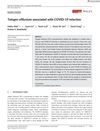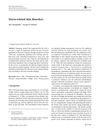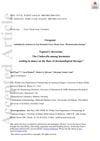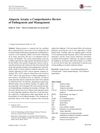TLDR Many COVID-19 survivors, especially women, experience hair loss and skin color changes, needing specific post-recovery care.
The study at Afzalipour Hospital in Kerman, Iran, involving 190 COVID-19-recovered patients, found that 76.3% experienced hair loss, mainly among females, with patterns similar to telogen effluvium, especially in the frontal region. Additionally, 15.3% reported changes in skin pigmentation. A significant link was identified between hair loss and arterial oxygen saturation levels. The study underscores the necessity for targeted post-COVID-19 care, particularly for women, to address these common issues and suggests that stress, malnutrition, and physiological changes due to COVID-19 may contribute to these dermatological symptoms.
 1 citations
,
October 2021 in “Indian Journal of Plastic Surgery”
1 citations
,
October 2021 in “Indian Journal of Plastic Surgery” The document concludes that doctors should use a systematic method and tools like trichoscopy to diagnose hair loss causes.
 44 citations
,
January 2021 in “Dermatologic Therapy”
44 citations
,
January 2021 in “Dermatologic Therapy” COVID-19 may cause hair loss due to infection stress or treatments.
 39 citations
,
June 2020 in “Dermatologic Therapy”
39 citations
,
June 2020 in “Dermatologic Therapy” The COVID-19 pandemic led to an increase in untreated hair diseases and showed the importance of teledermatology.
 31 citations
,
May 2020 in “Dermatologic Therapy”
31 citations
,
May 2020 in “Dermatologic Therapy” Quarantine stress likely worsened hair loss in women, but video consultations helped manage their condition and reduce anxiety.
 56 citations
,
August 2019 in “Clinical, Cosmetic and Investigational Dermatology”
56 citations
,
August 2019 in “Clinical, Cosmetic and Investigational Dermatology” The document concludes that Telogen Effluvium is a hair loss disorder that can be assessed with the modified wash test and may be treated with clobetasol foam, with patient management being important.
 67 citations
,
July 2016 in “Reviews in Endocrine and Metabolic Disorders”
67 citations
,
July 2016 in “Reviews in Endocrine and Metabolic Disorders” Stress can worsen skin conditions by affecting hormone levels and immune response.
 January 2022 in “Dermatology Review”
January 2022 in “Dermatology Review” Higher IL-31 levels are linked to worse itching in chronic kidney disease patients.
1 citations
,
December 2023 in “Life” PRP helps skin heal, possibly through special cells called telocytes.
6 citations
,
July 2023 in “Diabetology” Autologous micrografts significantly improve wound healing in diabetic conditions by speeding up tissue regeneration and reducing inflammation.
 9 citations
,
July 2020 in “Experimental Dermatology”
9 citations
,
July 2020 in “Experimental Dermatology” Topical L-thyroxine may help with wound healing and hair growth but should be used short-term due to potential risks.
 99 citations
,
July 2017 in “Clinical Reviews in Allergy & Immunology”
99 citations
,
July 2017 in “Clinical Reviews in Allergy & Immunology” New treatments for Alopecia Areata show promise but need to be more effective and affordable.









